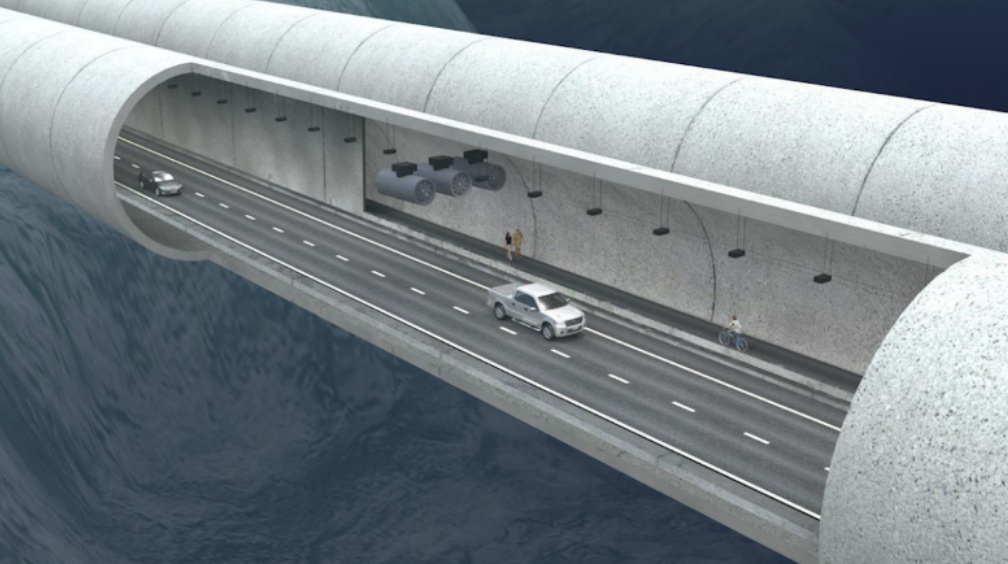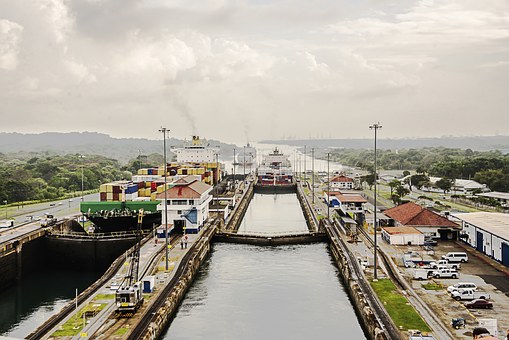Abstract
Norway is a Northern European country made up of thousands of fjords— expanses of water often surrounded by steep cliffs. For more than a century, the country has been using a combination of road, rail, and ferry crossings to span the trail from southern to northern Norway, a trip that takes over 20 hours by car [1]. Through the implementation of a floating tunnel, the Norwegian transportation authority hopes to cut this travel time in half [2]. The tunnel will utilize Archimedes’ principle to tackle complex engineering and environmental challenges with an innovative twist on modern technology.
Fording a Fjord
Bridges and tunnels are used all over the world to streamline modern transportation. What may seem trivial or commonplace today once required an advanced blend of mathematics and physics from early engineers. A new project has challenged engineers to push the boundaries of modern transportation: the Norwegian floating tunnel (Figure 1). The National Transport Plan E39 (NTP E39) has the lofty political aim of shortening the commute from southern Norway’s staple harbor town of Kristianstad to the northern town of Trondheim [2]. By car, this journey stretches over 1,100 kilometers and requires near 20 hours to complete [4]. The cumbersome archipelago of Norway’s western coast, which is made up of thousands of fjords of varying sizes, renders the journey impossible without the use of several ferries to complete the journey [1].
The concern of the Norwegian people and government for the environment places constraints on possible resolutions to this transportation conundrum [1]. Perhaps the most pressing challenge for engineers on the NTP E39 plan is how to pass the Sognefjord—a 3,700 meter stretch at its narrowest point between Lavik and Oppedal [1]. Although Norway already has 35 tunnels that run underwater, Sognefjord’s maximum depth of 1,300 meters (about one mile), makes standard underwater tunneling impractical and detrimental to the sensitive coastal ecosystem [5]. If the Sognefjord can be crossed, however, the Norwegian Public Roads Association (NPRA) hypothesizes that bridges and tunnels can be easily built for the six remaining fjord crossings [1].
A Bridge to Nowhere?
Underwater tunnels that descend over one mile below sea level, such as the Holland Tunnel in New York City, are dangerous and expensive. In these cases, engineers are forced to consider whether or not the necessity of a tunnel outweighs the safety risks that would be encountered with modern transportation. The NPRA considered both suspension and floating bridge types in its technical analysis of the Sognefjord crossing. The proposed suspension bridge would consist of a double tower construction, with each tower reaching higher than 150 meters, which is double the height of the Eiffel Tower [1]. Its span of 3,700 meters would break the world record of the longest suspension bridge [1]. To put that in perspective, a suspension bridge across the Sognefjord would be three times the length of the Golden Gate Bridge in San Francisco [1].
A second proposal was a “triple span floating suspension bridge” in which two of the bridge’s four towers would be on land on either side of the fjord, and two would be floating on pontoon-like structures anchored to the seafloor using rigging lines and anchors [1]. This proposal built off inspiration from the grand number of offshore oil and wind industries that are common in Norway. Each tower would have a total height of 200 meters with the pontoons supporting concrete floating towers boasting a 75 meter diameter. They would dive nearly 200 meters into the water and be anchored on either side with mooring lines- a common technique in the engineering of offshore oil rigs [1].
Is a Submerged Tunnel Really So New?
Briefly put — no. In 1996 the Forum of European National Highway Research Laboratories (FEHRL) explored the concept of building submerged floating tunnels in several principal locations in Europe [6]. A 100+ page report titled “Analysis of the Submerged Floating Tunnel Concept” outlined the basic concepts of Submerged Floating Tunnels (SFTs), design and construction engineering, safety, and environmental concerns. In fact, the paper introduces a brief timeline of underwater tunnels that spans at least 100 years.
Although running underwater tunnels have become more common, they are a distinct cry from floating underwater structures. The most obvious difference is perhaps that an underwater tunnel is completely anchored to a surface, namely bedrock. While a floating submerged tunnel is also fixed, it is done so with various methods (Figure 2). The range of anchoring techniques is necessary to stand against volatile movements caused by currents or watercraft movement [6].
How Does It Float?
Submerged floating tunnels (SFTs) generally float by the Archimedes Principle, which describes the upward force motion of an object that is submersed in a liquid. This principle can be applied to an SFT, which is lighter than water and is forced to the top surface of water- a phenomena described as positive buoyancy [6]. Negative buoyancy can be ascribed to SFTs that are heavier than water and describes the downward force as it sinks to the bottom.
Depending on the buoyancy design and environmental factors impacting the submerged floating tunnel, one of four engineering methods may be required to anchor the SFT in place (Figure 2), such as column or tension leg supports [6]. Pontoon supports, on the other hand, may be utilized to support a SFT that would otherwise sink [6]. As submerged floating tunnels are subject to external forces such as water current, earthquakes, sub-zero temperatures, and watercraft movement, more support is necessary to maintain a constant, stable environment for the tunnel [7]. This maintains a sense of safety and structural integrity of the tunnel.
The Sognefjord Submerged Floating Bridge
The submerged floating tunnel proposed by the NPRA to span the Sognefjord is designed as a curved concrete structure consisting of two tubes, one for each direction of traffic [8]. It will be anchored to bedrock at the entrance and exit points of the tunnel. Designed to have negative buoyancy, the tunnel will be anchored by placing approximately 15 floating pontoons on the water’s surface [1].
The FEHRL study indicated that submerged floating tunnels should be situated deep enough underwater to mitigate the impact of surface wind, weather and watercraft disturbance [6]. However, SFTs should not be placed so deep that the increasing water pressure becomes too great of an obstacle [7]. Depending on the type of SFT and its proposed location, tunnels can be as placed as deep as 100 meters below the sea level. This, however, is a maximum depth: most proposed submerged floating tunnels, including the Songnefjord SFT, are designed to be placed at a maximum of 30 meters below sea level [6, 7].
The Sognefjord SFT in particular is designed to be placed 20 meters (about 100 feet) below sea level [2]. Driving a car at this depth may sound frightening- however, the SFT buoyancy experienced at this depth should be virtually imperceptible [6]. Furthermore, the supportive pontoons above are designed and placed in a way that causes minimal impact to important military and cruise ship activity in the fjord above.
The next big question to tackle is this: How much will this cost? The answer doesn’t come cheap. The Sognefjord SFT is part of a 25 billion dollar E39 coastal highway improvement plan expected to be completed by 2035 [2, 4].
Safety First
Safety is a primary concern for all engineering studies concerning the feasibility of submerged floating tunnels [7]. The biggest concern is of the potential breach of water into the body of the tunnel. To combat this, safety routes (similar to modern tunnels) are integrated into the blueprints, ensuring a reliable exit in the event of an emergency [6]. It doesn’t stop there– a second concern is seismic activity [7]. These, and other natural disasters, are well planned for, and the impact of accidents (such as boat crashes) have been analyzed and considered in the Sognefjord tunnel [1], which would withstand the loss of several surface pontoons without sustaining damage to the tunnel below. Consequently, although a submerged floating tunnel has never before been built, the safety and experience for potential travellers is, by all calculations, projected to be equivalent to standard tunnel travel [6] [7].
Crossing New Expanses
According to experts, floating submerged tunnels are not only the future of transportation engineering, but may be the only promising way to cross great expanses [7]. The environmental impact of SFTs is also beneficial— as complex air treatment processes must be present to mitigate exhaust from underground vehicles, particulate matter that would otherwise be released untreated are processed and scrubbed before being released into the atmosphere [7]. Additionally, the sporadic ferry crossings currently used in Norway would obsolete and the associated carbon emissions consequently reduced [1]. The travel time between northern and southern Norway would be significantly reduced to just under 10 hours, lowering carbon emissions by 50%, and providing the economic benefits of saved time [1].
Although this method of engineering has yet to be successfully implemented, the Norwegian government remains optimistic for the promising environmental impact and traffic alleviation. Beyond that, the science and public demand make an underwater submerged tunnel an anticipated and a necessary advance in transportation technology [7].
References
[1] “Statens vegvesen – Coastal Highway Route E39 animation (English voice),” YouTube, 15-Apr-2013. [Online]. Available: https://www.youtube.com/watch?v=l7en6etg2mk&feature=youtu.be&t=263. [Accessed: 04-Sep-2016].
[2] N State, “Ferjefri E39 | Statens vegvesen,” Statens vegvesen. [Online]. Available: http://www.vegvesen.no/vegprosjekter/ferjefrie39. [Accessed: 04-Sep-2016]
[3] A. Marshall, “What It Takes to Keep a 7,700-Foot Floating Bridge From Doom,” Wired.com, 19-Apr-2016. [Online]. Available: https://www.wired.com/2016/04/takes-keep-7700-foot-floating-bridge-doom/. [Accessed: 03-Sep-2016].
[4] A. Marshall, “Yes, a ‘Submerged Floating Bridge’ Is a Reasonable Way to Cross a Fjord,” Wired.com, 07-Jul-2016. [Online]. Available: https://www.wired.com/2016/07/submerged-floating-bridge-isnt-worst-idea-norways-ever/#slide-2. [Accessed: 03-Sep-2016].
[5] J. Ramey, “Norway’s floating tunnel concept is both brilliant and terrifying,” Autoweek, 26-Jul-2016. [Online]. Available: http://autoweek.com/article/technology/norway-plans-worlds-first-submerged-floating-bridges. [Accessed: 04-Sep-2016].
[6] “An Analysis of the Submerged Floating Tunnel Concept,” FEHRL: 1996. [Online]. Available: http://www.fehrl.org/index.php?m=203. Image published by Transport Research Laboratory, after FEHRL, 1996. [Accessed: 03-Sep-2016].
[7] A.B. Kawade and S.P. Meghe, “Submerged Floating Tunnel,” Submerged Flaoting Tunnel. [Online] Available: http://www.engineeringcivil.com/submerged-floating-tunnel-html. [Accessed: 09-Sep-2016].
[8] L. Winkless, “Could Norwegian Engineers Really Build A Floating Tunnel In A Fjord?,” Forbes, 22-Jul-2016. [Online]. Available: http://www.forbes.com/sites/lauriewinkless/2016/07/22/could-norwegian-engineers-really-build-a-floating-tunnel-in-a-fjord/#59d81fb56878. [Accessed: 04-Sep-2016].
[9] http://thescienceexplorer.com/technology/norway-invests-25-billion-plans-world-s-first-floating-underwater-tunnels




